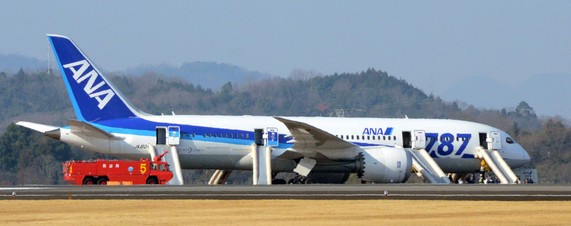Further updated with JAL groundings
Japan’s two major carriers All Nippon Airways and Japan Airlines have now grounded their fleets of Boeing 787 Dreamliners following an urgent descent to an emergency landing by an All Nippon ANA 787 making a domestic flight this morning.
Dreamliner operations by other airlines are expected to be grounded as well, given the seriousness of the reports coming out of Japan from both airline and regulatory sources.
The ANA emergency began shortly after one of its 787s left Yamaguchi on its way to Tokyo Haneda at 8 am local time when according to initial reports smoke was detected in its cockpit.
The ANA flight rapidly descended onto the airstrip at Takamatsu where all passengers and crew abandoned the revolutionary high composite airliner via emergency slides, during which five people are now reported to received ‘slight injuries.’
No cause has been established.
In quick succession first ANA and then Japan Airlines ordered the cessation of 787 services involving approximately 24 of the Dreamliners in total pending urgent inspections and evaluations.
A Japan Airlines 787 caught fire after landing at Boston’s Logan airport on 7 January, one of a number of seemingly unrelated but disturbing incidents with the jet that lead to the US Federal Aviation Authority holding a stage managed event in which its senior officials and Boeing management declared how safe the Dreamliner was while an open ended inquiry into its safety and certification processes was launched.
Since then two more sobering accident investigation updates have been released by the US National Transportation Safety Board, without the spectacle of the FAA compromising itself in the obsequious manner displayed at the announcement of the 787 review.

In the fast breaking series of reports out of Japan today the initial report of smoke in the cockpit was changed to the appearance of a 787 battery warning light and the detection of an unusual and possibly electrical smell by the pilots.
Both ANA and JAL fly the Dreamliner long distances over water and central Asia on some international flights.
The incident and grounding will undoubtedly feed a fox hunt mentality in some media, resulting in every minor incident in the never trouble free introduction of a new airliner type into service generating headlines and anxiety which may not be deserved or appropriate.
However a fire is a fire is a fire in an airliner. And a grounding is an indication of serious concern. When something catches fire in an airliner, or gets hot enough enough to smoke, the incident has to be cause for genuine alarm.
This incident occurred over Japan with an abundance of available airports with suitable runways and emergency equipment.
The critical question regarding what appears to be a rising set of seemingly unrelated incidents in 787s is what they might lead to mid way across the Indian Ocean to Perth, or over the middle of Africa, or Siberia, all places where there is either rising 787 activity, or will be in coming weeks.
This makes such incidents at this stage a legitimate but hopefully correctly reported stories. And it also underlines why the regulatory authorities in the US and Japan are engaged in open ended reviews of 787 safety and its certification procedures by which it was passed as safe for commercial service.








Crikey is committed to hosting lively discussions. Help us keep the conversation useful, interesting and welcoming. We aim to publish comments quickly in the interest of promoting robust conversation, but we’re a small team and we deploy filters to protect against legal risk. Occasionally your comment may be held up while we review, but we’re working as fast as we can to keep the conversation rolling.
The Crikey comment section is members-only content. Please subscribe to leave a comment.
The Crikey comment section is members-only content. Please login to leave a comment.